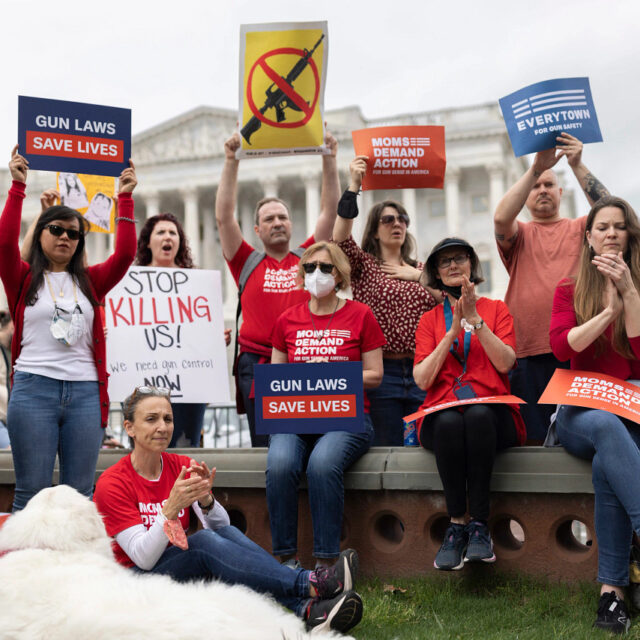Why a Federal Extreme Risk Law Must Allow for Emergency Removal of Firearms
Learn More:
All too often after an act of gun violence, law enforcement or family members point to warning signs that the shooter posed a risk to themselves or others. We can’t prevent every tragedy, but we can give the people who are in a position to see these warning signs a way to intervene. That’s why Congress must pass Extreme Risk legislation (a policy also referred to as ERPO or Red Flag) that empowers families and law enforcement to intervene when there is evidence that someone poses a threat to themselves or others. Nineteen states and DC1CA, CO, CT, DE, FL, HI, IL, IN, MD, MA, NV, NJ, NM, NY, OR, RI, VT, VA and WA have already passed their own state Extreme Risk laws, and Congress should be supporting them in this endeavor and working to ensure all Americans have access to this policy.
In designing a federal policy, Congress should be careful to not establish grant funding standards that penalize states with strong laws already in place—including emergency firearm removal, a policy that is a critical component of every existing state Extreme Risk law and that is core to saving lives and preventing tragedy.
Congress should not pass a bill like H.R. 744, which would penalize states with strong Extreme Risk laws, denying funding to those with emergency firearm removal policies.
H.R. 744 purports to give federal money to states with their own ERPO laws, but would in actuality provide funding for zero of the 15 states with existing processes. It refuses federal dollars to any state with emergency (“ex parte”) orders that allow or require removal of firearms—a consensus policy currently in place in all 19 ERPO states.
Emergency firearm removal is the first and most critical intervention in the ERPO process, allowing for immediate action at the moment of highest risk—within a system that protects due process rights.
How it works:
A family member or law enforcement officer may seek immediate ex parte relief in an emergency where a person poses a threat to themselves or others. The court orders that the person may not purchase any firearms, and must turn in any firearms in their possession, pending a full hearing at which they may appear and challenge the issuance of a longer-term order.
Why it matters:
Emergency firearm removal has already been critical in averting suicide in ERPO states. For example, in February 2018, a man in Portland, Oregon dialed 911 and threatened suicide with a gun. The responding officer found 10 firearms, including a loaded handgun easily accessible to both the man and his three-year-old son. Using Oregon’s recently enacted ERPO law, the officer immediately petitioned a court and was able to temporarily remove the firearms. By intervening at a clear moment of crisis, this officer may have prevented the man from taking his own life.
We must learn from the past. In too many tragedies—Parkland, Aurora, Tucson—there were clear warning signs that the shooters posed a threat, but law enforcement had no way to prevent them from accessing the firearms they used to kill dozens of innocent people.
Why it’s constitutional:
Courts have routinely rejected due process challenges to ex parte firearms prohibition and removal orders. These cases have rejected the need for a pre-deprivation hearing with both parties because the interest in protecting victims outweighs the risk of erroneous deprivation of the firearms, and the period between the ex parte removal order and the full hearing is relatively short (between a few days and a few weeks).2U.S. v. Calor, 340 F.3d 428, 432 (6th Cir. 2003); Kampf v. Kampf, 603 N.W.295, 383-384 (Michigan Ct. App. 1999) (citing Mitchell v. W.T. Grant, 416 U.S. 600); North Carolina v. Poole, 228 N.C. App. 248, 262-264 (N.C. Ct. App. 2013); Herbert v. Reynolds, No. 2:07- CV-91 PPS, 2009 WL 3010510 at *10 (N.D. Ind. Sept. 15, 2009). See also Razzano v. County of Nassau, 765 F.Supp.2d 176, 186 (E.D.N.Y. 2011) and Richer v. Parmelee, 189 F.Suppp.3d 334, n. 8 (D.R.I. 2016).
In a seminal procedural due process case, the Supreme Court held that a hearing was not required prior to the deprivation of disability benefits as long as there is a right to a meaningful hearing thereafter.3Mathews v. Eldridge, 96 S. Ct. 893, 903 (1976).
Multiple courts have upheld the constitutionality of statutes that permit ex parte orders that deprive respondents of important rights, such as the right to remain in their home and see their children.4See, e.g., Lossman v. Pekarske707 F.2d 288, 291 (7th Cir. 1983) (Posner, J.) (citing Duchesne v. Sugarman, 566 F.2d 817, 825 (2d Cir. 1977)); Nollet v. Justice of the Trial Court of the Commonwealth of MA, 83 F.Supp.2d 204, 207, 213 (D.Mass. 2000). Cf Blazel v. Bradley 698 F.Supp. 756, 768 (W.D.Wisc. 1988) (upholding an ex parte statute, but finding that it was unconstitutionally applied where the petitioner failed to allege the risk of immediate harm).
But under legislation like H.R. 744, a state’s ex parte emergency order may not include a prohibition on firearm possession.
Rather than removing guns immediately, a potential shooter could have up to three weeks’ notice before a hearing could be held, giving them ample time to act on a suicide or mass shooting threat and leaving families and law enforcement powerless to stop them from accessing guns.
Congressional action can help states expand the reach of their Extreme Risk laws and give more Americans access to this critical intervention tool that can save lives. Congress would be acting contrary to public safety and punishing states that have already acted if it made funding contingent on having weak laws that don’t allow for the emergency removal of firearms.


